TRURO — The Wampanoag Nation Singers and Dancers performed here on Aug. 5 in front of a crowd that included the market’s usual Monday shoppers along with Mass. Dept. of Agricultural Resources Commissioner Ashley Randle. The event was organized to celebrate both the national and state farmers market weeks.
Mashpee Wampanoag
EARTH DAY
A Blessing of the Land for a Wetu in Truro
Prayers to the creator remember the Paomet people and celebrate the spring
TRURO — Brian Weeden, chairman of the Mashpee Wampanoag tribe, asked for a moment of silence to remember the Paomet people. Weeden was standing on the grounds of the Highland House Museum in North Truro, where one of the tribe’s traditional dwellings, a wetu, is being erected. Weeden and other Wampanoag leaders were gathered there on April 22 for a blessing of the land and groundbreaking ceremony.
The Paomet tribe no longer exists. “I almost had tears thinking about them,” said Earl “Soaring Eagle” Cash, medicine man for the Mashpee Wampanoag. “It came across my heart,” he said after leading the ceremony to bless the land where the wetu will be built. “They’re here right now. That’s why we honor our ancestors.”
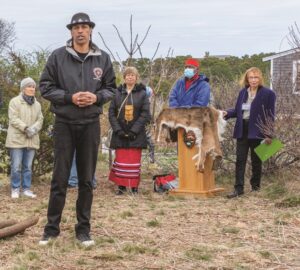
The wetu, a domed structure traditionally used as a seasonal dwelling, will be built by Annawon Weeden, Brian’s father, with the help of students from Truro Central School. Annawon and Brian Weeden, Cash, and about a dozen others who traveled from Mashpee for the day belong to one of two federally recognized Wampanoag tribes (the other is the Aquinnah on Martha’s Vineyard). In the early 17th century, the Wampanoag comprised at least 24 recorded tribes.
The ceremony on Saturday invoked traditional beliefs and customs that the Paomet likely practiced on this land for thousands of years.
“We’re going to honor the cedar poles for giving their lives to build this wetu,” said Cash to an audience of over 100 people seated in a circle. “They are above us. They are our sisters, our teachers. This is how we honor them,” he said before asking the audience to widen the circle and help bring in long cedar poles to be arranged in groups of two or three, spiraling from the center like spokes of a wheel.
When the activity subsided and a hush settled over the group, Cash began walking around the poles sprinkling tobacco on each one. The Wampanoag clan mothers, a group of four women dressed in colorful skirts, followed him, doing the same. Other tribe members joined in. “Tobacco is male energy,” Cash later explained. It is a sacred crop, he said.
Along with the chief and the medicine man, “the clan mothers keep connections and families together,” said Marlene Lopez, a Rabbit Clan mother. “We show up if people need help or guidance. We’re all-around aunties.”
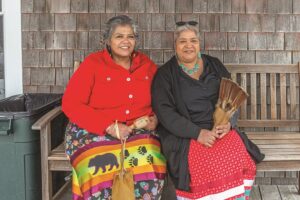
After the tobacco was dispersed, Cash shrouded himself in a deerskin and lit sage ensconced in a conch shell. He approached his tribe members and fanned smoke from the burning sage over them — a tradition called smudging.
Annawon stood in the center of the circle and spoke a greeting in Wôpanâak, a language revitalized in recent years after generations without living speakers.
He dedicated the event to their late chief, Vernon “Silent Drum” Lopez, who died on April 3 at age 100, and to Susan Howe, the late president of the Truro Historical Society who was instrumental, along with vice president Helen McNeil-Ashton, in planning the wetu project and securing funding for it through the Truro Community Preservation Committee. “She is missed, but I feel her presence,” Annawon said of Howe.
Annawon then walked around the circle fanning the sage smoke over each person, one by one, while Cash waved an eagle feather in the center. “The eagle feather sends your prayers to the creator,” Cash explained after the ceremony. “It’s the bird that flies the highest; it’s so sacred to us.”
The ceremony was slowly paced. At times the clan mothers played hand instruments, but there were also pauses with silence. “It’s not about how fast you do it. It’s about the creator speaking to you to do things,” said Cash. “In our world, when we do things like this, there’s no such thing as time.” The ceremony felt more intuitive than prescribed or liturgical. As Brian Weeden said at the outset, “It’s about what comes to you throughout the ceremony.”
Brian spoke of the spring season as the Wampanoag New Year, a time when “everything comes back to life. We see the herring coming up from the ocean back into the rivers. With new life come new journeys and new beginnings.”
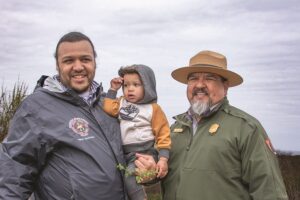
At one point during the ceremony Annawon brought his son and grandson to the center. “We stand here before you as three generations of our tribe,” he said. As the wetu is being built, he said, “I’m inviting each and every one of you to come with your multiple generations and place a tie on this home where the poles intersect, where our lineages and our generations intersect here on this land.”
The ceremony ended with a circle dance open to all. “This dance is a form of us giving back to the Earth,” said Annawon. “We’re trying to caress Mother Earth with our feet.” Roger Williams had seen the exact same dance, he said, and described it in vivid detail. Annawon asked Mayflower descendants to raise their hands. “Don’t be ashamed,” he said, as a few hands went up. “Your ancestors met ours. This dance is a gesture of welcoming.
“We hold hands to contain physical energy,” he continued. Annawon and the Clan Mothers sang in harmony while beating drums; tribal members and the entire audience held hands, stepping side to side in a dance rotating around the cedar poles.
After the ceremony concluded, McNeil-Ashton said, “The Truro wetu will be a real and symbolic presence in our town that honors the indigenous people, the Wampanoag Nation, who have been stewards of this land for thousands of years.”
Chuck Sams, director of the National Park Service, came from Washington, D.C. to attend the event and celebrate Earth Day and National Park Week here. He said the construction of the wetu on National Seashore land is a learning opportunity and represents “restorative justice for land that had originally been taken from tribal people.” The cooperative relationship between the Wampanoag and the Cape Cod National Seashore, he added, is serving as a model for other national initiatives. Funding for Saturday’s ceremony came from the Friends of the Cape Cod National Seashore.
Sams introduced himself as Mockingbird With Big Heart. “I come from the place of the Big Spring, which is now located on the Umatilla Indian Reservation in Northeast Oregon,” he said.
He told a story of coming to Cape Cod almost 30 years ago. When one of his tribal elders heard he would visit the area, she ran to her car and came back with a bundle to give to the first Wampanoag elder he would meet. “We would not have our daylight if they did not pray every morning and bring the sun back to us,” said the woman.
“It’s about the connection to this area and this place,” said Brian Weeden. At one point all this was Wampanoag territory, he said.
“As a people, we have undergone so many different things and overcome so many different things,” said Cash. “We’re not even supposed to be here. But here we are. Through the love of our ancestors, the love of our elders, the love of each other, and of our children.”
Editor’s note: An earlier version of the article, published in print on April 27, incorrectly identified the source of funding for the wetu project as the Truro Historical Commission. It was the Truro Community Preservation Committee.
CULTURE
The Red Hawk Singers and Dancers Bring Stories to the Stage
Wampanoag performers use song, dance, and narrative to teach about their tribe
PROVINCETOWN — CheeNulKa Pocknett and David Pocknett Jr. of the Red Hawk Singers and Dancers put on a program of music and dance at the Provincetown Schools’ Fishermen Hall on Saturday that had an audience of some 150 guests hanging on every drumbeat.
This Week in Eastham
Meetings Ahead
Go to eastham-ma.gov/calendar-by-event-type/16 and click on a meeting to read its agenda. That document will provide information about how to view and take part remotely.
Thursday, Nov. 19
- Affordable Housing Trust, 11 a.m.
- Board of Health, 3 p.m.
- Harbor Planning Committee, 4 p.m.
Monday, Nov. 23
- Visitors Tourism and Promotion Services Board, 4:30 p.m.
Tuesday, Nov. 24
- Conservation Commission on-site public meeting, 8:15 a.m.
- Conservation Commission, 6 p.m.
Conversation Starters
Covid-19 Update
As of Nov. 12, Eastham had two new active cases within the last 14 days, 19 cases considered recovered, and no deaths.
Council on Aging Services Suspended
The Council on Aging (COA) medical transportation and meal delivery services have been suspended, effective Nov. 16, after a staff member tested positive for Covid-19. Health Agent Jane Crowley said the town was notified of the positive test on Sunday, Nov. 15.
“They’re suspended for a period of time. At least a week, maybe more,” Town Administrator Jacqui Beebe said of the medical transportation and meal delivery services.
The COA had been closed to the public and was providing only transportation and meal delivery services, according to Beebe.
Crowley said on Tuesday that all contact tracing had been completed. She did not know if the COA employee was involved with the meal delivery or transportation services.
Beebe informed the select board of the staff member’s positive test at their Nov. 16 meeting, noting it was the first case of a town employee testing positive for coronavirus.
Wampanoag Reclaim Beaches
The select board approved a request by the Eastham 400 Commemoration Committee to extend the Mashpee Wampanoag tribe’s aboriginal rights to include use of Eastham’s town-managed beaches.
Tribal card holders will be issued seasonal visitor beach stickers at no charge.
Jim Russo, chair of the 400 Commemoration Committee, said the issue was brought to his attention during the filming of the Sunset Series videos, when he learned that tribal cards only gave off-reservation aboriginal rights for hunting, fishing, and trapping.
“As chair of the Eastham 400, I’d like to ask the select board to extend these rights to include access to Eastham town-managed beaches without cost,” said Russo.
“We’ve come to realize we can do more and correct the narrative that’s been out there for eons,” said Russo.” We can never go back to the way it was 400 years ago, but hopefully this is a gesture of our being able to share.”
“I was really excited when I saw this proposal,” said board chair Jamie Demetri. “Sometimes, with certain topics, money isn’t the issue. With this proposal, they’re definitely things that are far more important. Thank you to the 400 for bringing this to us.”
Conservation Agent Shana Brogan noted that only one or two shellfish permits had been issued to tribal card holders during her time with that department. —Linda Culhane
MAYFLOWER HISTORY, PART 1
For Indigenous People, a Different Kind of Mayflower Story
‘You can’t create a colony without creating people who are colonized’
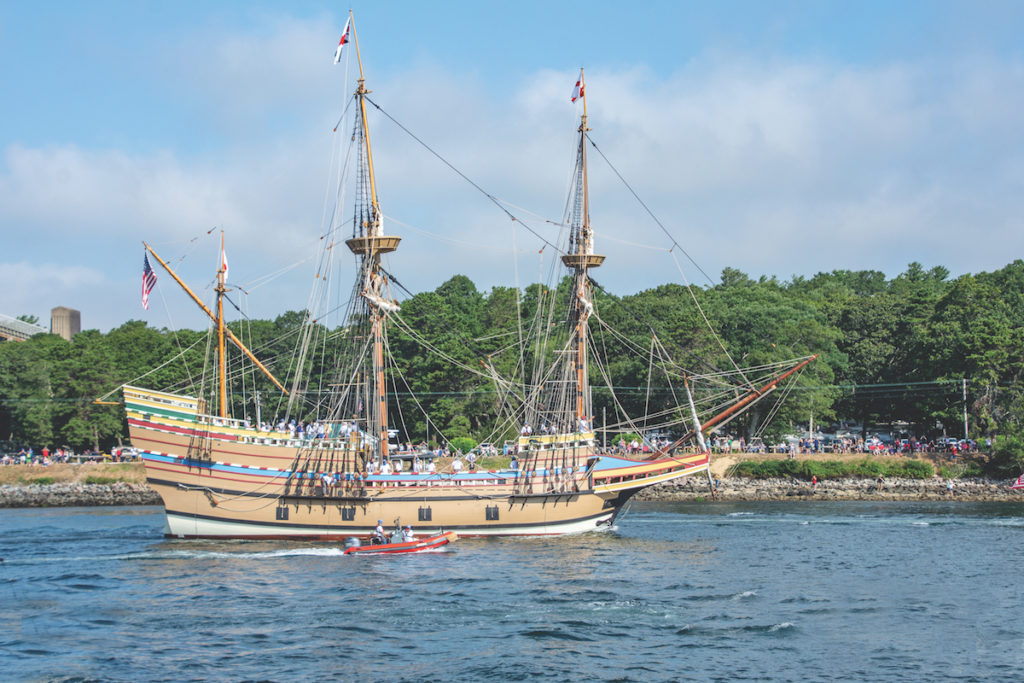
PROVINCETOWN — On Nov. 11, 1620, 130-odd sea-weary Brits stepped off the Mayflower and onto Provincetown’s sandy shores — into a new world, barely inhabited and ripe with possibility. Then they traveled south and west, to Plymouth; met the Wampanoag tribe, a well-meaning if not particularly sophisticated people; learned from them to cultivate the land; struck up a generous alliance; became the best of friends. So was born Plymouth Colony, and American history. Right?
“Bullshit,” said Paula Peters, a Wampanoag historian and former Mashpee Wampanoag Tribal Council member.
EASTHAM 400
Indigenous Artifacts Found at 1869 Schoolhouse Museum
Rediscovered objects reveal land was ‘intensely’ inhabited 3,500 years ago
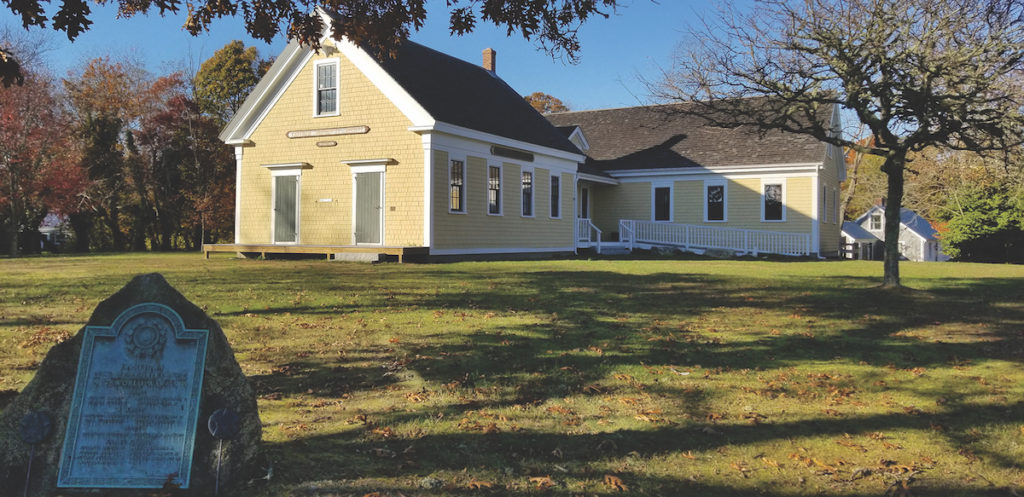
EASTHAM — While working to create a display as part of this year’s 400th anniversary of the Mayflower’s arrival on Cape Cod, volunteers at Eastham’s 1869 Schoolhouse Museum unearthed a trove of Native American artifacts that had been tucked away under the eaves, leading to the official designation of a new archeological site in Eastham.
“We wanted to do a balanced display,” said volunteer Patricia Donohoe of the museum’s plan to represent the Mayflower immigrants and the Cape’s indigenous people.
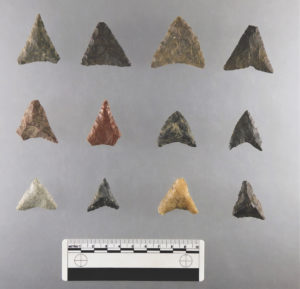
With just a few artifacts in its inventory of stone tools, the museum sought to expand that part of the display, eventually arranging for a loan of artifacts excavated from the National Park Service’s Carn’s Site on Coast Guard Beach. It was during a meeting with the park historian, recalled Donohoe, that museum president Eileen Seaboldt recognized that the park’s artifacts were similar to the items in cases stored under the museum building’s eaves.
After a visit to the Robbins Museum of Archaeology in Middleborough, the Eastham museum “knew they had something special,” said Donohoe. They also knew they would need to hire an archeologist to survey the collection.
A member of the Daughters of the American Revolution (DAR), Donohoe knew the organization had donated a case for the display. She went back to the DAR to ask for funding to hire an archaeologist. With a $1,000 DAR grant in hand, the museum hired archaeologist Dan Zoto.
“I like that the historical society was thinking about the people that were already here and wanting to highlight that history also,” said Zoto. “I think native people are underrepresented in the overall historical narrative. It was just neat to me with the timing, considering the Mayflower was the big highlight, that they went in a different direction.”
His survey of the 533 stone artifacts identified pieces from as far back as 9,500 to 10,000 years ago, including the Henry R. Guild collection that contained 48 artifacts, ranging from 3,500 years ago to the early 17th century, gathered from Guild’s property along the Salt Pond Creek in Eastham.
While unprovenanced artifacts can be used as teaching tools or displays, they have limited scientific value and not a lot can be learned about the past from them, said Zoto.
“The most important part of the project for me was that we were able to determine where one of the subcollections came from and we were able to put a new archeological site on the map,” Zoto said. “We were able to say this piece of property was inhabited rather intensely for the last 3,500 years.”
One of the collections was found to contain grave goods — items buried with a body. Zoto confirmed through documentation that the collector who gathered them had excavated at a Native American burial site in the 1930s.
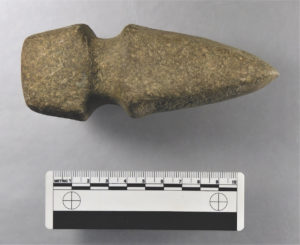
“With that information, we reached out to the Mashpee Wampanoag Tribe and informed them of our discoveries, and they were in the loop from then on,” said Zoto. “Eventually those artifacts will be given back to the tribe, which I think is important.”
The grave goods were considered culturally sensitive and that is why they are not going to be part of the final display, he explained.
While the museum remains closed to the public due to the pandemic, the Eastham Historical Society has a video presentation by Zoto available on its website at easthamhistoricalsociety.org/past-event.
SIGNS OF THE TIMES
State Flag and Seal Question Is on Wellfleet, Truro Warrants
Critics call the coat of arms an emblem of white supremacy
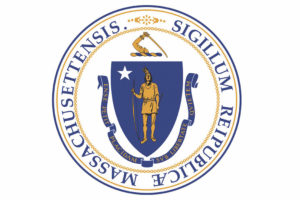
For more than 100 years, Massachusetts has used as its state seal a colonial swordsman’s disembodied arm brandished over a Native American. The same coat of arms has also been on the state flag since 1971. No wonder there is a move to change that at upcoming town meetings in Wellfleet on Sept. 12 and in Truro on Sept. 26.
Though Native Americans have protested the state flag for years, a group of legislatures have recently taken up the cause and are trying to create a commission to revise the flag, seal, and motto. The motto reads, in Latin, “Ense petit placidam sub libertate quietem,” or “By the sword we seek peace, but peace only under liberty.”
According to vexillologists, or flag scholars, both the motto and the sword refer not to the victory over Native American peoples but to the Pilgrims’ attitude about their own native country, England. Scholars say the sword is related to the motto on the ribbon, not to the indigenous man below it, Yvonne Abraham reported in the Boston Globe back in 2015.
But that distinction is lost on most. On the face of it, both the motto and sword relate directly to the Native American.
Paula Peters, of the Mashpee Wampanoag tribe, who consulted on the new Native American exhibit at the Pilgrim Monument and Provincetown Museum, said, “I remember as a teenager being offended by it and not knowing who to complain to. It really takes a movement to change something that has been so deeply ingrained.”
One could regard keeping the original seal as a matter of preserving state history, she said, but to her, it “is threatening and offensive and something that needs to be changed. There have been so many offensive mascots and slogans, it could become someone’s full-time job to put out all those fires.”
The seal is enshrined in stained glass at the State House.
This year, the Washington Redskins football team finally abandoned its name. And just last month, the Barnstable School Committee voted to retire its Red Raider mascot, according to the Cape Cod Times.
The articles on both Wellfleet and Truro town meeting warrants are nonbinding, but urge state Rep. Paul Mark, of the Second Berkshire District, and state Sen. Jo Comerford, of Hampshire, Franklin, and Worcester counties, to continue their “strong support” for H.2776 and S.1877, which would form a 20-member commission to revise the flag and seal. Five seats would be reserved for Native Americans, five for legislators, and the remainder for historical and cultural representatives. The legislation is before the Joint Committee on State Administration and Regulatory Oversight.
If it makes it out of committee and is passed, it must be signed by Gov. Charlie Baker, who has stated publicly that he is “open to discussions about changing the state seal,” according to the State House News Service.
